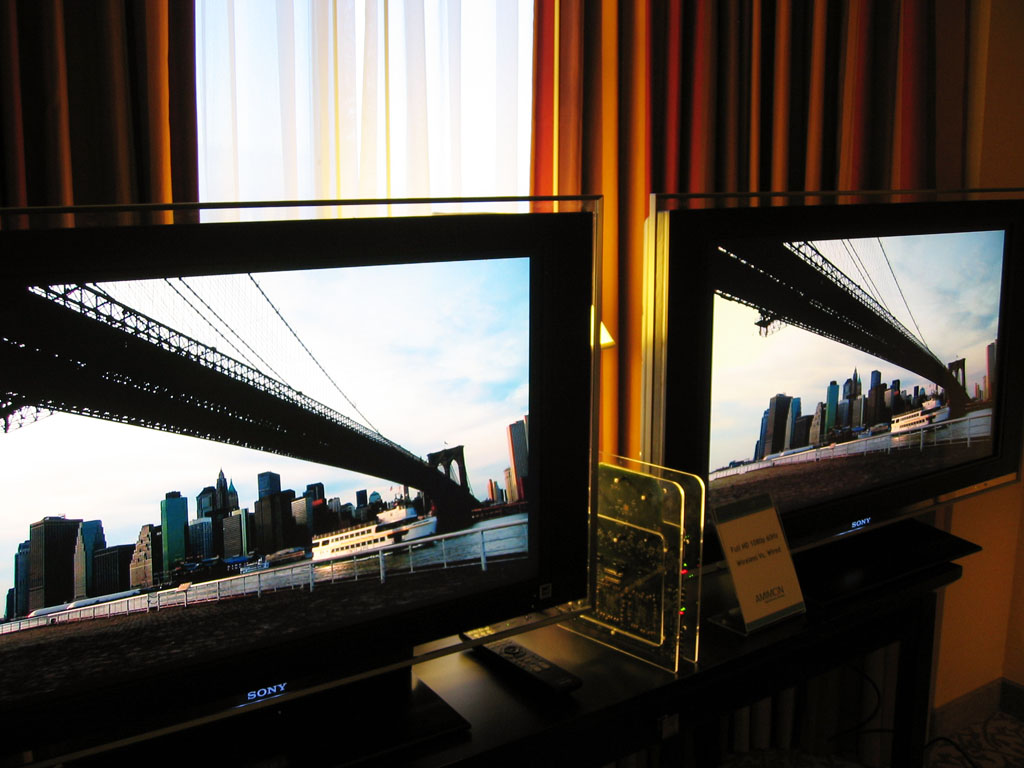CES '09: Morsels From Our Meetings
More USB 3.0 And Wireless TV
Symwave claims that there’s also a lot of work going into the USB 3.0 driver to improve its efficiency. Though it’d be possible for USB 2.0 to transfer at around 50 MB/s, you generally see it moving data about half that fast. When USB 3.0 goes to market, it’s expected to sustain somewhere are 300 MB/s instead. Granted, the demo we saw only showed sustained 80 MB/s transfers, but that’s about all you’d expect from a single SATA drive. Realizing those higher-end speeds will require larger RAID arrays.
As with past peripheral interfaces, such as eSATA and USB 2.0, Symwave expects devices to support USB 3.0 before the controllers (and invariably chipsets) start incorporating support. Fortunately, USB 3.0 devices will plug into USB 2.0 ports in the interim.
The most applicable application of USB 3.0 right out of the gate, according to the representatives we talked to, is external storage. Funny, we thought, eSATA is just now gaining traction in the same field. So why would anyone want to bother with USB 3.0 when you can get native SATA performance using the external specification? Briefly, enthusiasts probably won’t want to replace their eSATA devices with USB 3.0 right away, since a USB device will require a controller to adapt native SATA interfaces anyway.
USB 3.0 hardware and software is still very young. So, if you were holding off on buying a new X58 motherboard or were planning on avoiding the first round of AM3 platforms hoping for USB 3.0 shortly thereafter, don’t hold your breath. The general consensus in Symwave’s Hilton suite was that it’d be somewhere around back-to-school time in 2010 before the controllers and peripherals were both online to complete the ecosystem. Even still, we’re anxious to see both sides of the equation surface and start enabling high-speed applications beyond just the external storage Symwave is forecasting.
Wireless HDTV? What’s The Catch?
Our next stop was to Amimon’s suite, where the Israeli startup was showing off televisions employing its WHDI technology, which uses a 5 GHz MIMO engine to transmit video data wirelessly. Rather than using the 2x2 antenna configuration found on most 802.11n devices, WHDI is employing 4x5 to enable ample bandwidth for its application. Amimon’s director of product management, Uri Kanonich, emphasized that the displays he was showcasing are already shipping, so the tech itself was nothing new.
All of the Amimon-powered televisions in the suite were referred to as two-piece TVs consisting of the transmitter box and the receiver-equipped panel itself (incidentally, the displays were significantly thinner as a result of shedding the connectivity electronics normally found in single-piece TVs). By making all of your A/V connections to the transmitter itself, you eliminate the wires that’d normally need to run from a PS3, DVD player, or stereo receiver to the set itself.
Get Tom's Hardware's best news and in-depth reviews, straight to your inbox.
As a natural skeptic of wireless technology and anything relating to audio or video that’s also temporally sensitive, it was important to understand how the transmitter gets information to the receiver without any sacrifice in quality or the addition of noticeable latency in high-bit rate workloads.
Current page: More USB 3.0 And Wireless TV
Prev Page Introduction Next Page More Wireless TV And SFF Core i7-
neiroatopelcc So a new socket is planned for mainstream core i7 systems? If that's the case, why even invest in an x58 in the first place?Reply -
squatchman Reading hard!Reply
"Core i7 variant later this year with on-chip graphics, a different socket interface, and two channels of DDR3 memory support. "
It sounds like a crippled version of i7. Dual channel memory that takes DDR3 and some weak IGP? No thank you. -
enewmen At about that time, the socket LGA-1366 and LGA-1567 will be moving to server space while the LGA-1156 is for Desktop platforms. The good news is the Desktop platform when Sandy Bridge is released should be a lot faster for apps like games, recoding, etc. While the server platform will be better for databases, VMs, and other high-IO applications. I don't know yet if Sandy Bridge will be LGA-1156 or 1366, but I guess 1156.Reply
.001 cents worth. Lots of info on the web. -
cangelini squatchmanReading hard!"Core i7 variant later this year with on-chip graphics, a different socket interface, and two channels of DDR3 memory support. "It sounds like a crippled version of i7. Dual channel memory that takes DDR3 and some weak IGP? No thank you.Reply
It's all about getting that architecture into the mainstream though, right. For as well as it performs, i7 is still an expensive proposition. -
JonnyDough Too expensive. Which is why Phenom II seems to be picking up a bit of steam. Intel always seems to have issues with socket changes.Reply -
TwoDigital Reading through multiple web sites (including Intel's 2009 roadmap presentations) the socket 1366 is being targeted at 'enthusiast' users. They are also releasing a socket 1567 server connect (replacing the current Xeon socketj 771) and an entry-level socket 1160.Reply
Rumor has it the 1160 will retain the dual-channel memory controller system. The current i7s are based on LGA 1366 and the high-end motherboards I would expect to stay that way for the foreseeable future.

